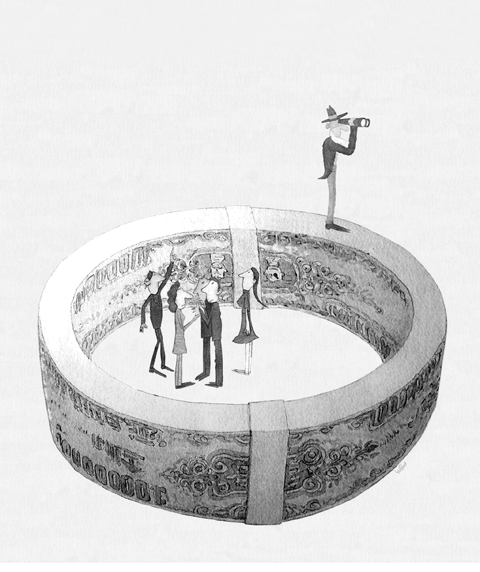To paraphrase former British prime minister Winston Churchill, never have so many billions of dollars been pumped out by so many governments and central banks. The US government is pumping US$789 billion into its economy, Europe US$255 billion and China US$587 billion. The US Federal Reserve increased its stock of base money last year by 97 percent, the European Central Bank (ECB) by 37 percent. The Federal funds rate in the US is practically zero, and the ECB’s main refinancing rate, already at an all-time low of 2 percent, will likely fall further in the coming months.
The Fed has given ordinary banks direct access to its credit facilities, and the ECB no longer rations the supply of base money, instead providing as much liquidity as banks demand. Since last October, Western countries’ rescue packages for banks have reached about US$4.3 trillion.
Many now fear that these huge infusions of cash will make inflation inevitable. In Germany, which suffered from hyper-inflation in 1923, there is widespread fear that people will again lose their savings and need to start from scratch. Other countries share this concern, if to a lesser extent.

But these fears are not well founded. True, the stock of liquidity is rising rapidly. But it is rising because the private sector is hoarding money rather than spending it. By providing extra liquidity, central banks merely reduce the amount of money withdrawn from expenditure on goods and services, which mitigates, but does not reverse, the negative demand shock that hit the world economy.
This is a trivial but important point that follows from the theory of supply and demand. Think of the oil market, for example. It is impossible to infer solely from an increase in the volume of transactions how the price of oil will change. The price will fall if the increase resulted from growth in supply, and it will rise if the increase resulted from growth in demand.
With the increase in the aggregate stock of money balances, things are basically the same. If this increase resulted from an increase in supply, the value of money will go down, which means inflation. But if it resulted from an increase in demand, the value of money will increase, which means deflation. Obviously, the latter risk is more relevant in today’s conditions.
If the underlying price trend is added to this, it is easily understandable why inflation rates are currently coming down everywhere. In the US, the annual inflation rate fell from 5.6 percent last July to 0.1 percent in December, and in Europe from 4.4 percent last July to 2.2 percent in January.
At the moment, no country is truly suffering deflation, but that may change as the crisis deepens. Germany, with its notoriously low inflation rate, may be among the first countries to experience declining prices. The most recent data show that the price index in January was up by only 0.9 percent year on year.
This deflationary tendency will create serious economic problems, which do not necessarily result from deflation as such, but may stem from a natural resistance to deflation. In each country, a number of prices are rigid, because sellers resist selling cheaper, as low productivity gains and wage defense by unions leave no margin for lower prices. Thus, deflationary pressure will to some extent result in downward quantity adjustments, which will deepen the real crisis.
Moreover, even if prices on average exhibit some downward flexibility, deflation necessarily increases the real rate of interest, given that nominal interest rates cannot fall below zero. The result is an increase in the cost of capital to firms, which lowers investment and exacerbates the crisis. This would be a particular problem for the US, where the Fed allowed the Federal funds rate to approach zero in January.
The only plausible inflationary scenario presupposes that when economies recover, central banks do not raise interest rates sufficiently in the coming boom, keeping too much of the current liquidity in the market.
Such a scenario is not impossible. This is the policy Italians pursued for decades in the pre-euro days, and the Fed might one day feel that it should adopt such a stance.
But the ECB, whose only mandate is to maintain price stability, cannot pursue this policy without fundamental changes in legislation. Moreover, this scenario cannot take place before the slump has turned into a boom. So, for the time being, the risk of inflation simply does not exist.
Japan provides good lessons about where the true risks are, as it has been suffering from deflation or near-deflation for 14 years. Since 1991, Japan has been mired in what Harvard economist Alvin Hansen, a contemporary of Keynes, once described as “secular stagnation.”
Ever since Japan’s banking crisis began in 1990, the country has been in a liquidity trap, with central bank rates close to zero, and from 1998 to 2005 the price level declined by more than 4 percent. Japanese governments have tried to overcome the slump with Hansen’s recipes, issuing one Keynesian program of deficit spending after the other and pushing the debt-to-GDP ratio from 64 percent in 1991 to 171 percent last year.
But all of that helped only a little. Japan is still stagnating. Not inflation, but a Japanese-type period of deflationary pressure with ever increasing public debt is the real risk that the world will be facing for years to come.
Hans-Werner Sinn is a professor of economics and finance at the University of Munich and president of the Ifo Institute.
COPYRIGHT: PROJECT SYNDICATE

Chinese state-owned companies COSCO Shipping Corporation and China Merchants have a 30 percent stake in Kaohsiung Port’s Kao Ming Container Terminal (Terminal No. 6) and COSCO leases Berths 65 and 66. It is extremely dangerous to allow Chinese companies or state-owned companies to operate critical infrastructure. Deterrence theorists are familiar with the concepts of deterrence “by punishment” and “by denial.” Deterrence by punishment threatens an aggressor with prohibitive costs (like retaliation or sanctions) that outweigh the benefits of their action, while deterrence by denial aims to make an attack so difficult that it becomes pointless. Elbridge Colby, currently serving as the Under
The Ministry of the Interior on Thursday last week said it ordered Internet service providers to block access to Chinese social media platform Xiaohongshu (小紅書, also known as RedNote in English) for a year, citing security risks and more than 1,700 alleged fraud cases on the platform since last year. The order took effect immediately, abruptly affecting more than 3 million users in Taiwan, and sparked discussions among politicians, online influencers and the public. The platform is often described as China’s version of Instagram or Pinterest, combining visual social media with e-commerce, and its users are predominantly young urban women,
Most Hong Kongers ignored the elections for its Legislative Council (LegCo) in 2021 and did so once again on Sunday. Unlike in 2021, moderate democrats who pledged their allegiance to Beijing were absent from the ballots this year. The electoral system overhaul is apparent revenge by Beijing for the democracy movement. On Sunday, the Hong Kong “patriots-only” election of the LegCo had a record-low turnout in the five geographical constituencies, with only 1.3 million people casting their ballots on the only seats that most Hong Kongers are eligible to vote for. Blank and invalid votes were up 50 percent from the previous
Japanese Prime Minister Sanae Takaichi lit a fuse the moment she declared that trouble for Taiwan means trouble for Japan. Beijing roared, Tokyo braced and like a plot twist nobody expected that early in the story, US President Donald Trump suddenly picked up the phone to talk to her. For a man who normally prefers to keep Asia guessing, the move itself was striking. What followed was even more intriguing. No one outside the room knows the exact phrasing, the tone or the diplomatic eyebrow raises exchanged, but the broad takeaway circulating among people familiar with the call was this: Trump did